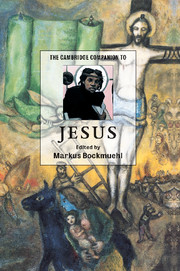Book contents
- Frontmatter
- Introduction
- Part I The Jesus of history
- Part II The History of Jesus
- 8 Sources and methods
- 9 Quests for the historical Jesus
- 10 The quest for the real Jesus
- 11 Many gospels, one Jesus?
- 12 The Christ of the Old and New Testaments
- 13 Jesus in Christian doctrine
- 14 A history of faith in Jesus
- 15 The global Jesus
- 16 Jerusalem after Jesus
- 17 The future of Jesus Christ
- Bibliography
- General Index
- Scripture Index
12 - The Christ of the Old and New Testaments
from Part II - The History of Jesus
Published online by Cambridge University Press: 28 May 2006
- Frontmatter
- Introduction
- Part I The Jesus of history
- Part II The History of Jesus
- 8 Sources and methods
- 9 Quests for the historical Jesus
- 10 The quest for the real Jesus
- 11 Many gospels, one Jesus?
- 12 The Christ of the Old and New Testaments
- 13 Jesus in Christian doctrine
- 14 A history of faith in Jesus
- 15 The global Jesus
- 16 Jerusalem after Jesus
- 17 The future of Jesus Christ
- Bibliography
- General Index
- Scripture Index
Summary
The belief that Jesus is the Christ has been fundamental to Christian faith down the ages. So basic a belief is it that it has become incorporated into essential Christian vocabulary. Already within the New Testament what is initially a Jewish title and role, 'the Christ/Messiah', as commonly in the gospels, becomes a proper name, Jesus Christ, as commonly in the letters of Paul and in Christian usage subsequently; and the followers of Jesus have been known as 'Christians' since earliest times (Acts 11.26).
It is a belief that can also be seen to encapsulate what came to be the Christian conviction that the Bible should be composed of two testaments, the scriptures of Israel in conjunction with the apostolic writings of the early church. For Christians the Bible contains both an Old Testament, where the Jewish category of ‘Christ/Messiah’ is formulated and becomes an important category for expressing hope in God’s action especially through the house of David, and a New Testament where Jesus fulfils and transforms Israel’s existing categories. Thus, major issues of biblical interpretation as a whole centre on the affirmation that Jesus is the Christ.
- Type
- Chapter
- Information
- The Cambridge Companion to Jesus , pp. 184 - 199Publisher: Cambridge University PressPrint publication year: 2001



